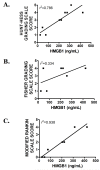Elucidating novel mechanisms of brain injury following subarachnoid hemorrhage: an emerging role for neuroproteomics
- PMID: 20043714
- PMCID: PMC3151677
- DOI: 10.3171/2009.10.FOCUS09223
Elucidating novel mechanisms of brain injury following subarachnoid hemorrhage: an emerging role for neuroproteomics
Abstract
Subarachnoid hemorrhage (SAH) is a devastating neurological injury associated with significant patient morbidity and death. Since the first demonstration of cerebral vasospasm nearly 60 years ago, the preponderance of research has focused on strategies to limit arterial narrowing and delayed cerebral ischemia following SAH. However, recent clinical and preclinical data indicate a functional dissociation between cerebral vasospasm and neurological outcome, signaling the need for a paradigm shift in the study of brain injury following SAH. Early brain injury may contribute to poor outcome and early death following SAH. However, elucidation of the complex cellular mechanisms underlying early brain injury remains a major challenge. The advent of modern neuroproteomics has rapidly advanced scientific discovery by allowing proteome-wide screening in an objective, nonbiased manner, providing novel mechanisms of brain physiology and injury. In the context of neurosurgery, proteomic analysis of patient-derived CSF will permit the identification of biomarkers and/or novel drug targets that may not be intuitively linked with any particular disease. In the present report, the authors discuss the utility of neuroproteomics with a focus on the roles for this technology in understanding SAH. The authors also provide data from our laboratory that identifies high-mobility group box protein-1 as a potential biomarker of neurological outcome following SAH in humans.
Figures


Similar articles
-
Blood pressure changes after aneurysmal subarachnoid hemorrhage and their relationship to cerebral vasospasm and clinical outcome.Clin Neurol Neurosurg. 2014 Oct;125:36-40. doi: 10.1016/j.clineuro.2014.06.023. Epub 2014 Jul 9. Clin Neurol Neurosurg. 2014. PMID: 25083804
-
Changes in the cerebrospinal fluid lipid profile following subarachnoid hemorrhage in a closed cranium model: Correlations to cerebral vasospasm, neuronal cell death and Interleukin-6 synthesis. A pilot study.J Stroke Cerebrovasc Dis. 2020 Sep;29(9):105054. doi: 10.1016/j.jstrokecerebrovasdis.2020.105054. Epub 2020 Jun 23. J Stroke Cerebrovasc Dis. 2020. PMID: 32807460
-
Effect of statin treatment on vasospasm-related morbidity and functional outcome in patients with aneurysmal subarachnoid hemorrhage: a systematic review and meta-analysis.J Neurosurg. 2017 Aug;127(2):291-301. doi: 10.3171/2016.5.JNS152900. Epub 2016 Oct 7. J Neurosurg. 2017. PMID: 27715439
-
Molsidomine for the prevention of vasospasm-related delayed ischemic neurological deficits and delayed brain infarction and the improvement of clinical outcome after subarachnoid hemorrhage: a single-center clinical observational study.J Neurosurg. 2016 Jan;124(1):51-8. doi: 10.3171/2014.12.JNS13846. Epub 2015 Jul 10. J Neurosurg. 2016. PMID: 26162034
-
Targeting High Mobility Group Box 1 in Subarachnoid Hemorrhage: A Systematic Review.Int J Mol Sci. 2020 Apr 14;21(8):2709. doi: 10.3390/ijms21082709. Int J Mol Sci. 2020. PMID: 32295146 Free PMC article.
Cited by
-
Relationship between plasma high mobility group box-1 protein levels and clinical outcomes of aneurysmal subarachnoid hemorrhage.J Neuroinflammation. 2012 Aug 11;9:194. doi: 10.1186/1742-2094-9-194. J Neuroinflammation. 2012. PMID: 22883976 Free PMC article.
-
All's well that transcribes well: non-coding RNAs and post-stroke brain damage.Neurochem Int. 2013 Nov;63(5):438-49. doi: 10.1016/j.neuint.2013.07.014. Epub 2013 Aug 15. Neurochem Int. 2013. PMID: 23954844 Free PMC article. Review.
-
Fatal hemorrhagic stroke in a Caucasian girl with moyamoya disease.Childs Nerv Syst. 2013 Aug;29(8):1381-5. doi: 10.1007/s00381-013-2089-5. Epub 2013 Apr 3. Childs Nerv Syst. 2013. PMID: 23549955
-
CSF Proteomics of Patients with Hydrocephalus and Subarachnoid Haemorrhage.Transl Neurosci. 2019 Oct 2;10:244-253. doi: 10.1515/tnsci-2019-0040. eCollection 2019. Transl Neurosci. 2019. PMID: 31637049 Free PMC article.
-
The Role of Circulating Tight Junction Proteins in Evaluating Blood Brain Barrier Disruption following Intracranial Hemorrhage.Dis Markers. 2015;2015:860120. doi: 10.1155/2015/860120. Epub 2015 Oct 25. Dis Markers. 2015. PMID: 26586924 Free PMC article.
References
-
- Finishing the euchromatic sequence of the human genome. Nature. 2004;431:931–945. - PubMed
-
- Abbott NJ, Revest PA, Romero IA. Astrocyte-endothelial interaction: physiology and pathology. Neuropathol Appl Neurobiol. 1992;18:424–433. - PubMed
-
- Agnello D, Wang H, Yang H, Tracey KJ, Ghezzi P. HMGB-1, a DNA-binding protein with cytokine activity, induces brain TNF and IL-6 production, and mediates anorexia and taste aversion. Cytokine. 2002;18:231–236. - PubMed
-
- Apetoh L, Ghiringhelli F, Tesniere A, Criollo A, Ortiz C, Lidereau R, et al. The interaction between HMGB1 and TLR4 dictates the outcome of anticancer chemotherapy and radiotherapy. Immunol Rev. 2007;220:47–59. - PubMed
Publication types
MeSH terms
Substances
Grants and funding
LinkOut - more resources
Full Text Sources
Research Materials

